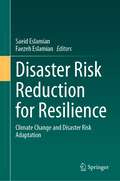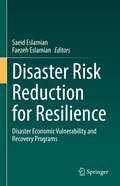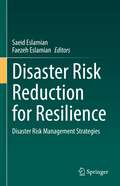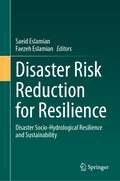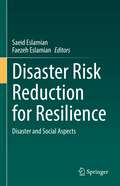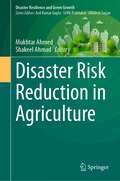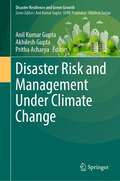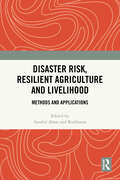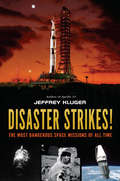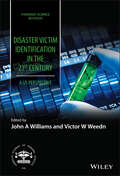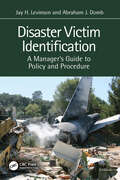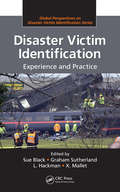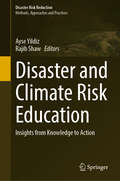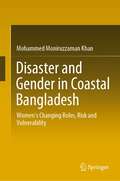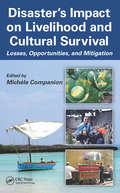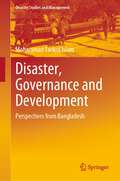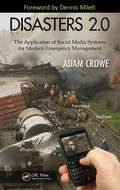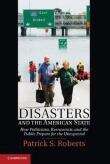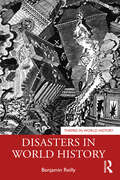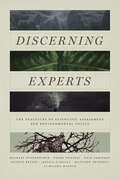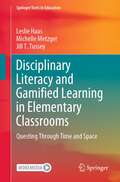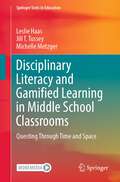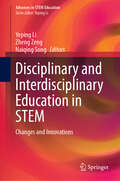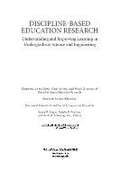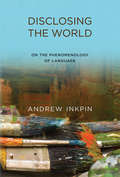- Table View
- List View
Disaster Risk Reduction for Resilience: Climate Change and Disaster Risk Adaptation
by Saeid Eslamian Faezeh EslamianThis book is part of a six-volume series on Disaster Risk Reduction and Resilience. The series aims to fill in gaps in theory and practice in the Sendai Framework, and provides additional resources, methodologies, and communication strategies to enhance the plan for action and targets proposed by the Sendai Framework. The series will appeal to a broad range of researchers, academics, students, policy makers, and practitioners in engineering, environmental science and geography, geoscience, emergency management, finance, community adaptation, atmospheric science, and information technology.This volume offers indigenous approaches to disaster risk reduction, community sustainability and climate change resilience, as well as agro-ecological innovations for improving resilience to climate change. The focus is on adaptation strategies for sustainable terrestrial and marine ecosystems to reduce the impacts of anthropogenic factors that exacerbate disaster risk, including hydro-meteorological services for climate resilience, food security measures in agriculture and livestock, flood mitigation plans, and increased climate change education and awareness. The book concludes with three case studies in Africa detailing the impacts of strengthened climate change resilience measures, adaptive social protections, and improved water availability through hydro-electric technologies.
Disaster Risk Reduction for Resilience: Disaster Economic Vulnerability and Recovery Programs
by Saeid Eslamian Faezeh EslamianThis book is part of a six-volume series on Disaster Risk Reduction and Resilience. The series aims to fill in gaps in theory and practice in the Sendai Framework, providing additional resources, methodologies, and communication strategies to enhance the plan for action and targets proposed by the Sendai Framework. The series will appeal to a broad range of researchers, academics, students, policy makers, and practitioners in engineering, environmental science and geography, geoscience, emergency management, finance, community adaptation, atmospheric science, and information technology.This volume focuses on the concepts of economic and development vulnerability, discussing the roles of physical, social, cultural, political, economic, technological, and development factors that contribute to disaster impacts and threat levels on vulnerable populations. This approach explores how the resilience of individuals and communities can be increased in the face of future hazard threats, and how post-disaster efforts are planned for and implemented to manage risk reduction and the potential outcomes of hazard threats. Topics addressed in the boom include disaster recovery reform and resilience, recovery, and development programs, place-based reconstruction policies, resilient and sustainable disaster relief, and recovery programs, sustainable community development, and disaster recovery and post-hazard recovery strategies.
Disaster Risk Reduction for Resilience: Disaster Risk Management Strategies
by Saeid Eslamian Faezeh EslamianThis book is part of a six-volume series on Disaster Risk Reduction and Resilience. The series aims to fill in gaps in theory and practice in the Sendai Framework, and provides additional resources, methodologies and communication strategies to enhance the plan for action and targets proposed by the Sendai Framework. The series will appeal to a broad range of researchers, academics, students, policy makers and practitioners in engineering, environmental science and geography, geoscience, emergency management, finance, community adaptation, atmospheric science and information technology. This volume offers the international guidelines and global standards for resilient disaster risk reduction and lessons learned from disasters, particularly the COVID-19 and Cholera pandemics. A resilient health system and an effective disaster risk management Index are then suggested. The book further emphasizes urban resilience strategies with local authorities, adaptation strategies for urban heat at regional, city and local scales, and lessons from community-level interventions. Also addressed are coastal erosion, displacement and resettlement strategies. Land use planning and green infrastructure are suggested as tools for natural hazards reduction. Human security in times of climate change and urban heat at regional, city and local scales is discussed for an integrated action, with case studies based in Manila, Burkina Faso, Chad, Mauritania, Niger, Senegal, Nigeria, India, Spain, and Ghana. Structure design for cascading disasters resulting from mining and flooding is presented and sustainable smart city planning using spatial data is recommended.
Disaster Risk Reduction for Resilience: Disaster Socio-Hydrological Resilience and Sustainability
by Saeid Eslamian Faezeh EslamianThis book is part of a six-volume series on Disaster Risk Reduction and Resilience. The series aims to fill in gaps in theory and practice in the Sendai Framework, and provides additional resources, methodologies and communication strategies to enhance the plan for action and targets proposed by the Sendai Framework. The series will appeal to a broad range of researchers, academics, students, policy makers and practitioners in engineering, environmental science and geography, geoscience, emergency management, finance, community adaptation, atmospheric science and information technology.This volume discusses the implementation of socio-hydrological resilience measures to curb the impacts on vulnerable communities of hydrologic diasters such as coastal floods, drought, water scarcity, and thunderstorms. The book provides a framework for sustainable hydrology-community interactions to inform local communities about the best practices to achieve hydrological resilience, and to implement resilient water infrastructure. Hydrological influences on the resilience of a region are comprehensively surveyed, and a "green economy strategy" is described and recommended for achieving climatic and hydrological sustainability.
Disaster Risk Reduction for Resilience: Disaster and Social Aspects
by Saeid Eslamian Faezeh EslamianThis book is part of a six-volume series on Disaster Risk Reduction and Resilience. The series aims to fill in gaps in theory and practice in the Sendai Framework and provides additional resources, methodologies, and communication strategies to enhance the plan for action and targets proposed by the Sendai Framework. The series will appeal to a broad range of researchers, academics, students, policy makers, and practitioners in engineering, environmental science, geography, geoscience, emergency management, finance, community adaptation, atmospheric science and information technology.This volume provides a holistic approach to developing disaster risk reduction strategies and policies, exploring the most effective ways to integrate physical and social science aspects of hazard resilience to better inform local populations. This risk-based approach to community resilience development is used to craft a collaborative system for crisis management, and allows for the implementation of nationally determined contributions (NDCs) through social innovation and community engagement to enhance community emergency response support and preparedness. Readers will also learn about education of disaster risk reduction, human health risk assessment, gendered perspectives in disaster response, recovery, and disaster management legislation.
Disaster Risk Reduction in Agriculture (Disaster Resilience and Green Growth)
by Mukhtar Ahmed Shakeel AhmadThis book is related to disaster risk reduction in agriculture particularly under changing climate. Climate change refers to significant, long-term changes in the global climate. There is unequivocal evidence that Earth is warming at an unprecedented rate. Human activity is the principal cause. The planets average surface temperature has risen to about 1oC since the late 19th century and most of the warming occurred in the past 40 years. The years 2016 and 2020 are tied for the warmest year on the record. Similarly, other evidence of rapid climate change includes warming of oceans, shrinking of ice sheets, retreating glaciers, decreasing snow cover, rising of sea level, declining artic sea ice, increased frequency of extreme events, ocean acidification and loss of biodiversity. Hence, climate change impacts, both extreme weather and slow-onset events, have impacted several sectors of the national economies and activities, in particular agriculture and food production, augmented by other challenges be it geopolitical, cost of finance or supply chain related, and in a time of increased food insecurity. Without CO2 fertilization, effective adaptation, and genetic improvement, each degree-Celsius increase in global mean temperature would, on average, reduce global yields of wheat by 6.0%, rice by 3.2%, maize by 7.4%, and soybean by 3.1%. Hence this book is useful as a study material to teach in the field of agriculture and climate change. The book is useful for instructors and postgraduate as well as undergraduate students involved in the study of climate change. The book also provide guidance to multiple stakeholders to design mitigation and adaptation efforts to climate change and ensure food security in the developing world.
Disaster Risk and Management Under Climate Change (Disaster Resilience and Green Growth)
by Anil Kumar Gupta Akhilesh Gupta Pritha AcharyaThis contributed volume is focused on SDG 3, 6, 7 ,9, 11, 15, and it covers extensive knowledge on damage and loss contexts of climate change in a developing country. India’s vast landscape with its diversity of eco-geo-physiography, socio-cultural, and developmental settings, coupled with climate change and anthropogenic factors, makes it one of the most disaster-prone countries of the world and, thus, representing almost all the disasters and extreme events associated with climate change, variability, and weather phenomenon. Besides common hazards,such as heavy rainfall, floods, drought, cyclone and heat wave, secondary and composite disasters like forest fires and disease epidemics are also covered with case studies and examples. Cross-cutting aspects like infrastructure resilience, gender and social equity concerns, legal and assessment tools, and futuristic vision have been covered well in the book. Disaster risk reduction, preparedness, and resilience as central themes of adaptation to climate change are presented through policy discussions, tools, and strategic analysis of past and recent lessons. This book is of common interest to a wider range of readers across policyplanning, academia, research, and professional practitioners having interest in adaptation, resilience building and sustainability in developing countries of the world. Though it is primarily a reference book, it can also serve as a textbook for university courses and professional trainings in climate change adaptation, disaster management, sustainability and strategic management studies.
Disaster Risk, Resilient Agriculture and Livelihood: Methods and Applications
by Asraful AlamThis volume discusses important issues associated with agricultural disaster risk, resilient agriculture, and livelihood. It highlights the role of sustainable development goals in reducing the impact of climate change on agriculture. The contributions found in this volume discuss methodological and innovative resilience approaches to various natural hazards including flood, landslide, environmental challenges, strategies of disaster risk management, livelihood, ecosystem services, and agricultural sustainability. It explores the relationship between climatic change and agricultural transformation. While throwing light on the role of ecosystem services in disaster risk reduction, the book explores the impact of land degradation and change on growth of agricultural production and food production. The book will be useful for students and researchers of geography, environmental sciences, disaster management, and environmental geology. It will also be useful for geographers, environmentalists, hydrologists, geomorphologists, planners, and professionals working on related ideas.
Disaster Strikes!: The Most Dangerous Space Missions of All Time
by Jeffrey KlugerTwelve thrilling and terrifying space-mission failures, told by the bestselling author of Apollo 13!There are so many amazing, daring, and exciting missions to outer space that have succeeded. But for every success, there are mistakes, surprises, and flat-out failures that happen along the way. In this collection, bestselling author and award-winning journalist Jeffrey Kluger recounts twelve such disasters, telling the stories of the astronauts and the cosmonauts, the trials and the errors, the missions and the misses.With stories of missions run by both Americans and Russians during the height of the space race, complete with photos of the people and machines behind them, this book delves into the mishaps and the tragedies, small and large, that led humankind to the moon and beyond.Praise for Disaster Strikes!:* "A thrill ride punctuated with spectacular failures--but also spectacular successes." --Kirkus Reviews, starred review* "The [is] text versatile, efficiently functioning as a collection of short reads or a balanced, book-length narrative . . . Always fascinating, at times unsettling, and highly recommended for elementary and middle school collections." --SLJ, starred review"Each compelling episode is crafted as a self-standing adventure, with an opening hook and a satisfying close, making this an excellent source for readalouds for middle-school classes as well as a pleasure for independent readers." --BCCB
Disaster Victim Identification in the 21st Century: A US Perspective (Forensic Science in Focus)
by Douglas H. UbelakerA comprehensive examination of all critical aspects of Disaster Victim Identification (DVI) As the frequency of both natural and man-made mass fatality disasters increases worldwide, the establishment of clear standards and best practices within the field of Disaster Victim identification (DVI) is of vital importance. Whereas most countries assign jurisdiction to law enforcement agencies following Interpol guidelines, DVI is the responsibility of the medical examiner and coroner in the United States. Disaster Victim Identification in the 21st Century is the first book of its kind to directly address the needs of DVI practitioners in the United States, covering the full spectrum of DVI from traditional methods such as fingerprints, odontology, and anthropology to advanced DNA identification technology. Approaching DVI from three perspectives—academic, government, and private industry—this comprehensive volume examines the history and current state of the discipline, the ongoing formation of national standards, the various methods of human identification, and the key challenges and future of DVI. In-depth chapters are written by leaders in the field with personal experience in human identification and mass fatality events. Provides practitioners with practical guidance on planning and taking part in DVI based on current national standards and best practices Discusses continued improvement in both traditional and emerging DVI methods Includes non-region-specific case studies and recommendations that can be easily adapted for international use Examines ethical and legal considerations in DVI, including suggestions for standardizing the victim identification process Describes the critical role of the Victim Information Center (VIC) in providing the comparative information required to go beyond presumptive identifications Part of the American Association for Forensic Sciences (AAFS) series, Disaster Victim Identification in the 21st Century: A US Perspective is an indispensable resource for forensic scientists, disaster planners, policymakers, medical examiners and coroners, law enforcement and emergency personnel, and upper-level undergraduate and graduate students in forensic sciences and emergency management.
Disaster Victim Identification: A Manager's Guide to Policy and Procedure
by Abraham J. Domb Jay H. LevinsonDisaster Victim Identification: A Manager’s Guide to Policy and Procedure’s guiding thesis explains why disaster victim identification (DVI) must be fundamentally integrated—at the outset—into general disaster planning and operations procedures. By doing so, it allows for pre-event assessment of any risks and vulnerabilities, in coordination with planning and response agencies, so that the on-site response isn’t the first time they have communicated and worked together. The book outlines the importance of exercising, interagency memoranda of understanding (MOU), and coordination in advance to provide the best, most effective response that optimally serves both the victims and the community. DVI requires a multi-disciplinary approach and, as such, plans should take into consideration and account for possible integration of outside assistance into the general work plan and flow. By doing this, practical action and measures—sometimes coordinated impromptu depending on the nature and scale of a disaster—can be undertaken both quickly and seamlessly. Coverage outlines the overall DVI process, its various methodologies, and how it serves as an integral part of overall disaster response. Disaster Victim Identification brings together the expertise of two professionals with longstanding, extensive first-hand experience in the field. This includes working at, as well as supervising coordination of, DVI response to such scenes. The book will be a welcome addition to professionals by examining what works, what doesn’t, and how to maintain best practices while avoiding common mistakes.
Disaster Victim Identification: Experience and Practice (Global Perspectives on Disaster Victim Identification)
by L. Hackman G. Sunderland X. Mallett S. BlackDisaster management has become an increasingly global issue, and victim identification is receiving greater attention. By raising awareness through past events and experiences, practitioners and policymakers can learn what works, what doesn‘t work, and how to avoid future mistakes. Disaster Victim Identification: Experience and Practice presents a
Disaster and Climate Risk Education: Insights from Knowledge to Action (Disaster Risk Reduction)
by Rajib Shaw Ayse YildizEducation serves as a cornerstone for gaining knowledge and taking initiative. However, despite efforts in disaster and climate risk education (DCRE), a gap often exists between awareness and meaningful action. To bridge this gap and promote a progression from awareness to empowerment, we offer the KIDA (Knowledge Interest Desire Action) framework. The foundation of this framework is a collaboration between schools, communities, and families, which calls for support from educational boards and local governments. Following international tragedies like the Turkey-Syria earthquake of 2023, as well as the ever-changing difficulties posed by climate change, DCRE has to be given priority immediately. Our book proposes a comprehensive strategy that includes governance, capacity building, education in schools and the community, and technology integration. Our insights, analyses, and practical policy suggestions are based on multidisciplinary research and worldwide case studies, with the goal of strengthening resilience and cultivating a generation committed to sustainability. This book provides a comprehensive exploration of DCRE. It aims to prepare individuals and communities to face the challenges of a changing world head-on by improving knowledge and promoting preparedness.
Disaster and Gender in Coastal Bangladesh: Women’s Changing Roles, Risk and Vulnerability
by Mohammed Moniruzzaman KhanThis volume explores the discourse of disaster and women in the existing social settings and state disaster-related affairs in coastal Bangladesh. It covers various issues ranging from disproportionate vulnerability, coping and adaptation mechanisms for women, limitations for promoting participation and involvement of women in the decision-making process both in family and community and changes in the role and responsibilities of women for reducing disaster risk and vulnerability. It contributes to the deconstruction of gender-based identity by addressing women's changing practices and roles in the coastal area in terms of the involvement of women with the development process, earning/income generation activities, decision-making process, access and entitlements to resources. This book presents the most current and inclusive circumstances of disaster and women of the coastal area in Bangladesh. The insights obtained through the eyes of a sociologist from a holistic perspective make this book different and unique. The book is of interest to researchers, academics, policymakers and professionals engaged in the social understanding of disaster studies, as well as to researchers and practitioners in interdisciplinary domains, including sociology, gender studies, social work, environmental studies, and development studies.
Disaster's Impact on Livelihood and Cultural Survival: Losses, Opportunities, and Mitigation
by Michèle CompanionMany facets of disasters generate interest among scholars and practitioners. However, a vital area of disaster research is consistently underemphasized. Little is written about the immediate and long-term impacts on a community‘s livelihood systems and the customs and practices of the culture affected. Disaster‘s Impact on Livelihood and Cultural S
Disaster, Governance and Development: Perspectives from Bangladesh (Disaster Studies and Management)
by Mohammad Tarikul IslamThis book unveils the nexus between disaster, governance and development with a particular focus on Bangladesh and examines the legislative and institutional aspects in mainstreaming disaster risk reduction into development planning. With the help of rich content analysis interpreting disaster management history of the country, it looks at the challenges associated with disaster management in the context of Bangladesh. The book highlights the most reasonable strategy on how to accelerate a paradigm shift from relief culture to DRR culture. It also assesses the viewpoint of how political economy influences governance and institutional strengthening, thus identifying obstructions and opportunities for mainstreaming disaster management into development. The book also lays emphasis on collaboration between public sector and private sector for the expansion of disaster risk reduction programme. It shows how multilevel governance works for professionalizing disaster management and throws light on policy frameworks developed. This book is a tremendous resource for scholars, practitioners and researchers of disaster management, environmental studies, development agencies, political science, public policy, development studies, governance, regional development, South Asian studies and local government, particularly those interested in disaster, governance and sustainable development.
Disasters 2.0: The Application of Social Media Systems for Modern Emergency Management
by Adam CroweEmerging social media and so-called Web 2.0 technologies will continue to have a great impact on the practice and application of the emergency management function in every public safety sector. Disasters 2.0: The Application of Social Media Systems for Modern Emergency Management prepares emergency managers and first responders to successfully appl
Disasters and the American State
by Patrick S. RobertsDisasters and the American State offers a thesis about the trajectory of federal government involvement in preparing for disaster shaped by contingent events. Politicians and bureaucrats claim credit for the government's successes in preparing for and responding to disaster, and they are also blamed for failures outside of government's control. New interventions have created precedents and established organizations and administrative cultures that accumulated over time and produced a general trend in which citizens, politicians and bureaucrats expect the government to provide more security from more kinds of disasters. The trend reached its peak when the Federal Emergency Management Agency adopted the idea of preparing for 'all hazards' as its mantra. Despite the rhetoric, however, the federal government's increasingly bold claims and heightened public expectations are disproportionate to the ability of the federal government to prevent or reduce the damage caused by disaster.
Disasters in World History (Themes in World History)
by Benjamin ReillyDisasters in World History surveys the development of disaster studies as a discipline as well as presenting historical case studies and theories used by historians to understand disasters. Disasters, here defined as the complex interaction between natural hazards and specific human vulnerabilities, have frequently left a mark on human history. Cataclysms have toppled dynasties, fueled massacres, and shaped the culture of societies frequently affected by natural hazards. This volume fosters understanding of such events by considering both social science theory and the natural science concepts relevant to disaster studies. In addition, the text makes heavy use of an emerging psychological theory relevant to disaster studies: the behavioral immune system, which helps to explain why xenophobic behavior and even violence often erupt in the aftermath of disasters. Chapters consider specific examples of disasters: earthquakes, tsunamis, volcanic eruptions, climate change (including modern anthropogenic climate change or global warming), and tropical cyclones.This book is an accessible resource, ideal for undergraduates and instructors in world history, environmental history, and disaster studies courses.
Discerning Experts: The Practices of Scientific Assessment for Environmental Policy
by Milena Wazeck Naomi Oreskes Dale Jamieson Michael Oppenheimer Keynyn Brysse Jessica O’Reilly Matthew ShindellDiscerning Experts assesses the assessments that many governments rely on to help guide environmental policy and action. Through their close look at environmental assessments involving acid rain, ozone depletion, and sea level rise, the authors explore how experts deliberate and decide on the scientific facts about problems like climate change. They also seek to understand how the scientists involved make the judgments they do, how the organization and management of assessment activities affects those judgments, and how expertise is identified and constructed. Discerning Experts uncovers factors that can generate systematic bias and error, and recommends how the process can be improved. As the first study of the internal workings of large environmental assessments, this book reveals their strengths and weaknesses, and explains what assessments can—and cannot—be expected to contribute to public policy and the common good.
Disciplinary Literacy and Gamified Learning in Elementary Classrooms: Questing Through Time and Space (Springer Texts in Education)
by Leslie Haas Michelle Metzger Jill T. TusseyThis textbook provides real world examples of how disciplinary literacy can incorporate gamified learning opportunities in elementary classrooms (grades K-5 or ages 5-11). It also presents concrete examples of how to seamlessly integrate literacy within other subjects in engaging and unique ways. Furthermore, this text offers practical information related to pedagogy, content, and differentiation for each lesson. Preservice teachers, practicing teachers, instructional coaches, and administrators can benefit from this user-friendly text and its companion digital components, allowing for replication of lessons based on national standards, backed by best-practices, and supported by differentiated pedagogy.This unique volume begins with engineering marvels that span across centuries and locations. The eight chapters focus on the following marvels in chronological order: Great Pyramid of Giza, Stonehenge, Leaning Tower of Pisa, Great Wall of China, Machu Picchu, Panama Canal, Golden Gate Bridge, and International Space Station. By focusing on these specific examples of human ingenuity, opportunities are created to delve into the historical and social aspects of each chapter’s focus. There are also occasions to explore the artistic merit and the art created about and around each focus. Additional teaching opportunities lie in understanding the science, engineering, technology, and math embedded in all featured marvels.Each chapter features an adventure roadmap in the form of a narrative quest set against the chapter’s marvel that guides teachers and student players through embedded activities. Activities are designed for lower elementary school (grades K-2 or ages 5-8) and upper elementary school (grades 3-5 or ages 8-11). Instructional support for both novice and career teachers is provided through differentiation strategies, resource materials, and teaching tips.
Disciplinary Literacy and Gamified Learning in Middle School Classrooms: Questing Through Time and Space (Springer Texts in Education)
by Leslie Haas Michelle Metzger Jill T. TusseyThis textbook prepares teachers to incorporate gamified learning experiences into middle school classrooms. Its focus provides concrete examples of how to seamlessly integrate literacy across disciplines in a fun, engaging, and unique way for all learners. Furthermore, this book offers practical information related to pedagogy, content, and differentiation for each lesson. Preservice teachers, practicing teachers, instructional coaches, and administrators can benefit from this user-friendly text and its companion digital components, allowing for replication of lessons based on national standards, backed by best-practices, and supported by differentiated pedagogy.This unique book begins with engineering marvels that span across centuries and locations. The ten chapters, in chronological order, are titled: Acropolis, Petra, Colosseum, Chichen Itza, Moai, Red Square, Taj Mahal, Neuschwanstein, Eiffel Tower, and Sydney Opera House. By focusing on specific examples of human ingenuity, opportunities are created to delve into the historical and social aspects of each chapter’s focus. There are also chances to explore the artistic merit and the art created about and around each marvel. Additional teaching moments lie in understanding the science, engineering, technology, and math embedded in all featured marvels. Each chapter offers material lists, resource materials, and visual/graphic images to support understanding. Teaching tips and differentiation strategies are also provided to support novice and career teachers alike.
Disciplinary and Interdisciplinary Education in STEM: Changes and Innovations (Advances in STEM Education)
by Yeping Li Zheng Zeng Naiqing SongThis book provides an international platform for educators from different STEM disciplines to present, discuss, connect, and develop collaborations in two inter-related ways: (1) sharing and discussing changes and innovations in individual discipline-based education in STEM/STEAM, and (2) sharing and discussing the development of interdisciplinary STEM/STEAM education. Possible relationships and connections between individual disciplines (like mathematics or physics) and STEM education remain under explored and the integration of traditionally individual discipline-based education in STEM education is far from balanced. Efforts to pursue possible connections among traditionally separated individual disciplines in STEM are not only necessary for the importance of deepening and expanding interdisciplinary research and education in STEM, but also for the ever-increasing need of reflecting on and changing how traditional school subjects (like mathematics or physics) can and should be viewed, taught, and learned. Scholars from eight countries/regions provide diverse perspectives and approaches on changes and innovations in STEM disciplinary and interdisciplinary education. Disciplinary and Interdisciplinary Education in STEM will be a great resource to students and researchers in STEM education as well as STEM curriculum developers and teacher educators internationally.
Discipline-Based Education Research
by Susan R. SingerThe National Science Foundation funded a synthesis study on the status, contributions, and future direction of discipline-based education research (DBER) in physics, biological sciences, geosciences, and chemistry. DBER combines knowledge of teaching and learning with deep knowledge of discipline-specific science content. It describes the discipline-specific difficulties learners face and the specialized intellectual and instructional resources that can facilitate student understanding. Discipline-Based Education Research is based on a 30-month study built on two workshops held in 2008 to explore evidence on promising practices in undergraduate science, technology, engineering, and mathematics (STEM) education. This book asks questions that are essential to advancing DBER and broadening its impact on undergraduate science teaching and learning. The book provides empirical research on undergraduate teaching and learning in the sciences, explores the extent to which this research currently influences undergraduate instruction, and identifies the intellectual and material resources required to further develop DBER. Discipline-Based Education Research provides guidance for future DBER research. In addition, the findings and recommendations of this report may invite, if not assist, post-secondary institutions to increase interest and research activity in DBER and improve its quality and usefulness across all natural science disciples, as well as guide instruction and assessment across natural science courses to improve student learning. The book brings greater focus to issues of student attrition in the natural sciences that are related to the quality of instruction. Discipline-Based Education Research will be of interest to educators, policy makers, researchers, scholars, decision makers in universities, government agencies, curriculum developers, research sponsors, and education advocacy groups.
Disclosing the World: On the Phenomenology of Language
by Andrew InkpinA phenomenological conception of language, drawing on Heidegger, Merleau-Ponty, and Wittgenstein, with implications for both the philosophy of language and current cognitive science.In this book, Andrew Inkpin considers the disclosive function of language—what language does in revealing or disclosing the world. His approach to this question is a phenomenological one, centering on the need to accord with the various experiences speakers can have of language. With this aim in mind, he develops a phenomenological conception of language with important implications for both the philosophy of language and recent work in the embodied-embedded-enactive-extended (4e) tradition of cognitive science. Inkpin draws extensively on the work of Martin Heidegger, Maurice Merleau-Ponty, and Ludwig Wittgenstein, showing how their respective conceptions of language can be combined to complement each other within a unified view. From the early Heidegger, Inkpin extracts a basic framework for a phenomenological conception of language, comprising both a general picture of the role of language and a specific model of the function of words. Merleau-Ponty's views are used to explicate the generic “pointing out”—or presentational—function of linguistic signs in more detail, while the late Wittgenstein is interpreted as providing versatile means to describe their many pragmatic uses. Having developed this unified phenomenological view, Inkpin explores its broader significance. He argues that it goes beyond the conventional realism/idealism opposition, that it challenges standard assumptions in mainstream post-Fregean philosophy of language, and that it makes a significant contribution not only to the philosophical understanding of language but also to 4e cognitive science.
